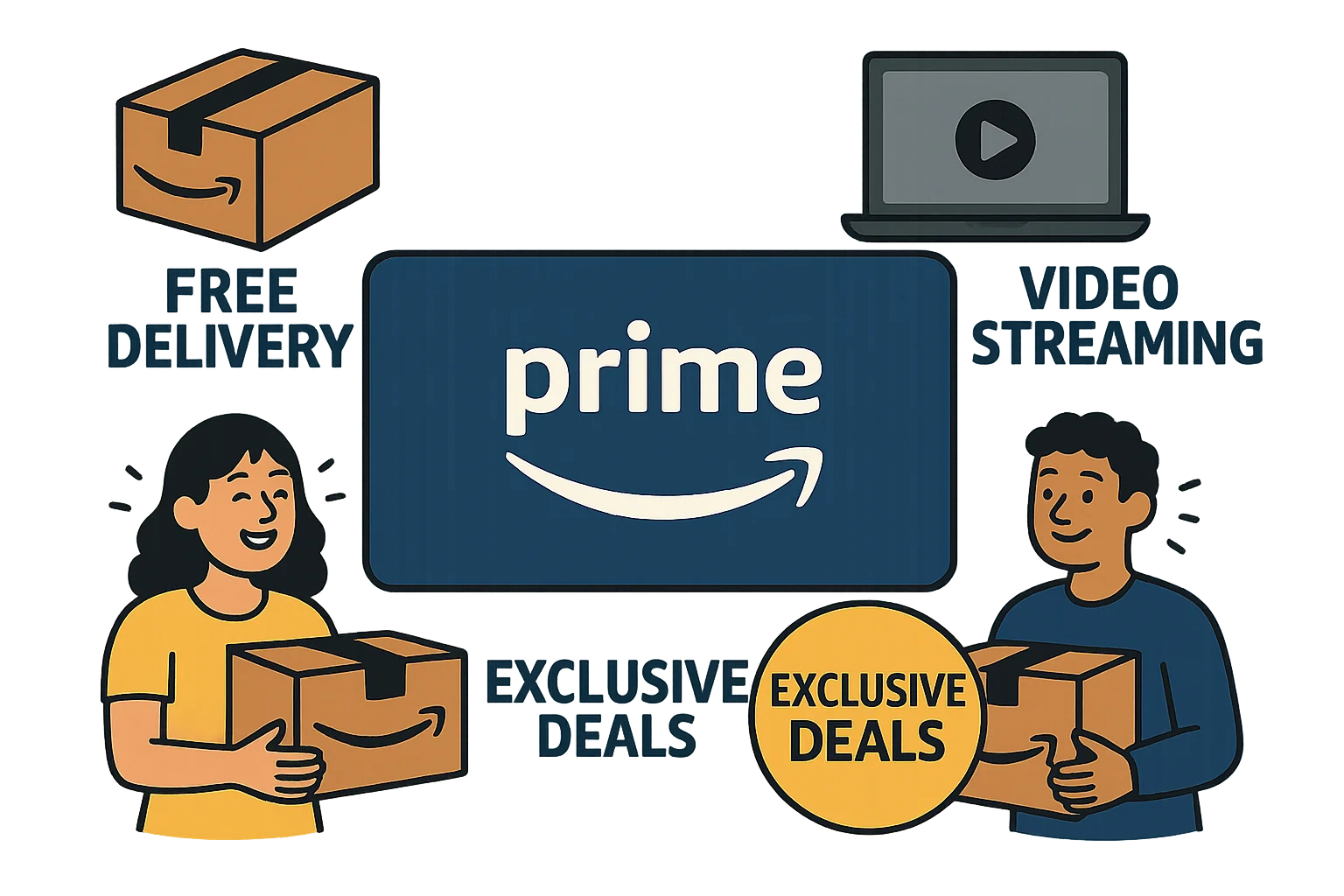Love them or hate them, Amazon has changed the way the world shops and the way companies market. From their relentless focus on the customer to their near-invisible ability to personalise every experience, Amazon is a masterclass in modern marketing. Whether you’re running a small e-commerce brand or leading a larger operation, there’s a lot to learn from how Amazon does things.
Now you might be thinking “why are a Stockport SEO company talking about Amazon?”, bare with us because in this blog we’re diving into the real strategies that power Amazon’s customer obsession and how you can apply them to your own business – regardless of size!

Why Amazon Always Starts with the Customer
Amazon doesn’t just say it puts the customer first, it actually builds every part of its business around that idea. Jeff Bezos famously described Amazon as “the most customer-obsessed company in the world,” and it shows. From the moment you land on their website to the second your parcel arrives, everything is designed to reduce friction and increase satisfaction.
This isn’t just about great Amazon customer service. Their obsession goes deeper, it’s about solving problems customers didn’t even know they had. Same day delivery? Predictive recommendations? One click checkout? All of it stems from constantly asking what would make this easier, faster or more helpful for the customer?
If you run a business, this is a powerful mindset shift. Instead of asking “how do we sell more?”, Amazon asks, “how do we help the customer more?” The sales come naturally as a result.

Using Data to Drive Every Marketing Decision
Amazon don’t do guessing. Their marketing and practically every other business decision is made based on data. From tracking what customers browse to how long they hover over a product image, Amazon captures everything. That data doesn’t just sit in a report, it drives action.
Every product recommendation, every email, every homepage layout tweak is informed by billions of micro-interactions. If a headline isn’t getting clicks, it’s gone. If people stop halfway through the checkout process, Amazon digs into why, always doing tests and looking for quick solutions until the numbers move.
This data-led approach is why their marketing feels so intuitive. It’s not that they’re psychic, they’re just paying very close attention to what the data is saying.
Even small businesses can adopt this mindset. You don’t need a team of analysts, just an appetite for testing and improvement. Tools like Google Analytics, Hotjar, Shopify reports, or email software dashboards offer plenty of actionable insights. If you want to see how smaller brands use this same data-driven thinking on social platforms, read our guide on the real ROI of free LinkedIn marketing – it shows how organic insights can fuel B2B growth.
Amazon’s marketing strategy is a masterclass in customer-centric innovation. For a detailed breakdown of their approach, including how they leverage data-driven decisions and omnichannel marketing, check out this comprehensive 2025 case study by Business Model Analyst.

How Amazon Gets It Right
If you’ve ever shopped on Amazon more than once, you’ve experienced their personalisation engine in action. Your homepage changes based on your browsing history. Your recommendations update constantly. Even the ads you see are tailored to your most recent searches or purchases, including factors like your order history and delivery preferences.
This is personalisation at scale – and it’s incredibly powerful!
Amazon doesn’t just personalise for the sake of it. They do it to reduce friction and make buying easier. If they can surface the right product faster, you’re more likely to click “Buy Now.” Their goal is to eliminate decision fatigue by making the right thing feel like the obvious thing.
For your business, you might not have Amazon’s algorithmic firepower, but you can still personalise. Even simple touches can make a big difference:
- Use a customer’s name in emails
- Recommend products based on previous purchases
- Tailor offers based on seasonal behaviour or cart activity
- Send location-based promotions
The key is to make people feel like your brand sees them not just as a data point, but as an individual. In a world flooded with generic ads, a little relevance goes a long way.

Turning Prime into a Loyalty Marketing Machine
Amazon Prime isn’t just a subscription, it’s a masterclass in long-term loyalty marketing.
For £8.99 a month, customers get free next-day delivery, Prime Video, music streaming, exclusive deals and more. On the surface, that’s a value-packed offer. However what Prime really does is lock customers into the Amazon business ecosystem.
Once you’re a Prime member, you’re less likely to shop elsewhere. Not because you can’t, but because Amazon has made the process so convenient, reliable and rewarding that it’s easier to stick with them. You don’t need a streaming service or a logistics empire to create loyalty. Just focus on delivering recurring value:
- Create a VIP or membership scheme
- Offer perks like early access, discounts or gifts
- Use subscriptions or loyalty points to encourage repeat purchases
- Prioritise fast, dependable service
Loyalty isn’t a programme it’s an ongoing relationship – Amazon treats it exactly that way.

From Discovery to Delivery
Amazon doesn’t just market products. It controls the full customer journey, from the moment you search for something to the moment it lands on your doorstep.
This includes the crucial area of delivery payments which they’ve streamlined to a science. Whether you’re ordering from your hometown or a different country, the process is fast, clear and consistent.
This end-to-end control means Amazon can eliminate friction at every touchpoint and the less friction, the more conversions.
You might not control the whole customer journey but you can optimise each stage:
- Ensure your ads match your landing pages
- Make your product pages clear and persuasive
- Simplify your checkout process
- Offer smooth post-sale communication
The more seamless the journey, the better the results.

Mastering Multi-Channel Marketing Without Losing Consistency
Amazon is everywhere. Google Ads, sponsored products, Instagram retargeting, Kindle homepages, Even Alexa voice prompts. It’s multi-channel marketing at its finest and yet, the messaging always feels familiar.
That’s no accident, Amazon has mastered brand consistency. The tone, design, product offering and value proposition remain clear, whether you’re in an email inbox or on a TikTok ad.
For smaller brands, this is a lesson in focus. Don’t try to be everywhere unless you can show up well in every place. Start with the channels your customers actually use and make sure your messaging aligns across each. Not sure whether SEO or social media should come first? Our breakdown of SEO vs social media explains how to balance both for visibility and long-term results.
A consistent voice builds trust and trust leads to conversions.

How Amazon Builds Brand Loyalty Without Saying a Word
Amazon doesn’t rely on emotional brand videos or epic taglines. Instead, it tells its story through user experience. Every step of the process, from the ease of ordering to the speed of delivery, reinforces a simple brand promise: we make life easier.
This is marketing that works without feeling like marketing. It’s subtle, embedded and it’s consistent.
The Amazon customer service experience is a key part of that story, often offering quick solutions to problems like missed deliveries, wrong items or returns. The process is efficient and automated but still feels human and helpful.
As a business owner, your brand story can be told the same way, not just on your About page, but through the way you answer emails, package goods and deal with returns.
What do you want customers to feel after every interaction? Build your marketing around that.

What You Can Apply to Your Own Business (Even on a Smaller Budget)
Amazon’s size is impressive, but its principles are accessible. Here’s what you can apply:
- Start with your customer – Solve problems, don’t sell features.
- Simplify the journey – Remove friction wherever you can.
- Use data – Even small insights can drive big improvements.
- Focus on retention – Happy customers = free marketing.
- Scale what works – Automate your wins.
- Be consistent – Across platforms, messages and experiences.
Customer experience isn’t just about what you say – it’s what you deliver. Every click, every touchpoint, every response matters.
Marketing like Amazon isn’t about having more money, it’s about having more intention.

Marketing with a ‘Day One’ Mentality
Jeff Bezos often talked about keeping Amazon in “Day One” mode, where they operated with the hunger, speed and innovation of a start-up. That mindset fuels their marketing: they keep evolving, testing, improving.
At the end of the day, marketing like Amazon isn’t about billion-pound budgets or tech empires, it’s about mindset. Start by obsessing over your customers – what do they need, what frustrates them and how can you make their life easier? Use the data you already have from emails, sales, or site traffic to guide decisions.
Personalise wherever you can, simplify every step of the customer journey and stay consistent across every touchpoint. You don’t need to be Amazon to think like Amazon. With a bit of intention, the right tools and a focus on delivering real value, any business (no matter the size) can build trust, loyalty and results that last. To stay ahead of fast-changing algorithms and consumer trends, see our deep dive into the latest 2025 marketing trends shaping SEO and PPC.
Want Help Applying These Strategies to Your Own Business?
If you want to see how the team at Rank Kings can help implement a marketing strategy that suits the direction you want your business to go in, then get in touch and we’ll have a chat.



